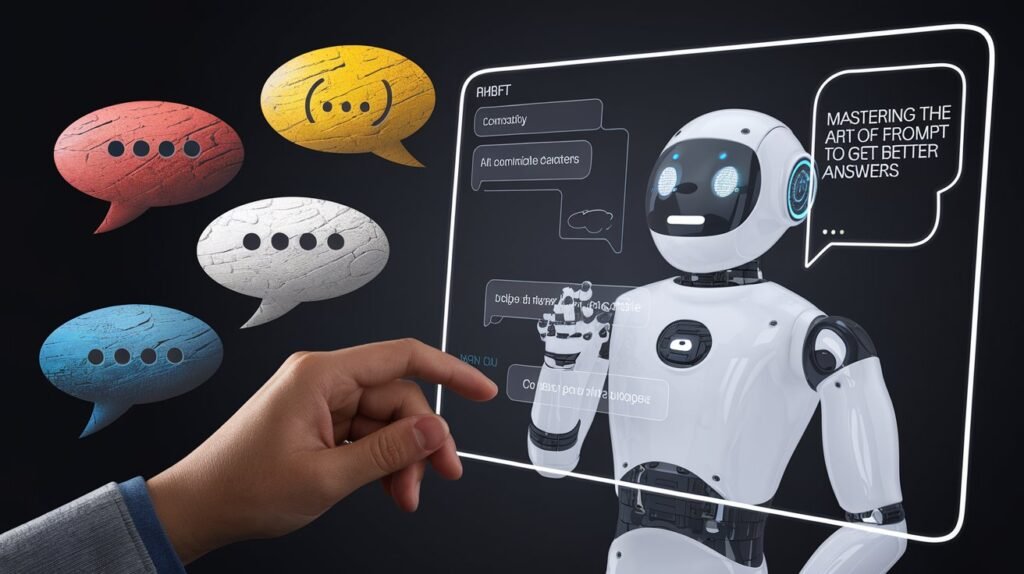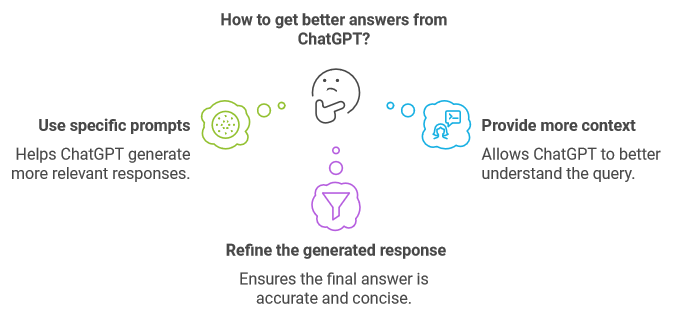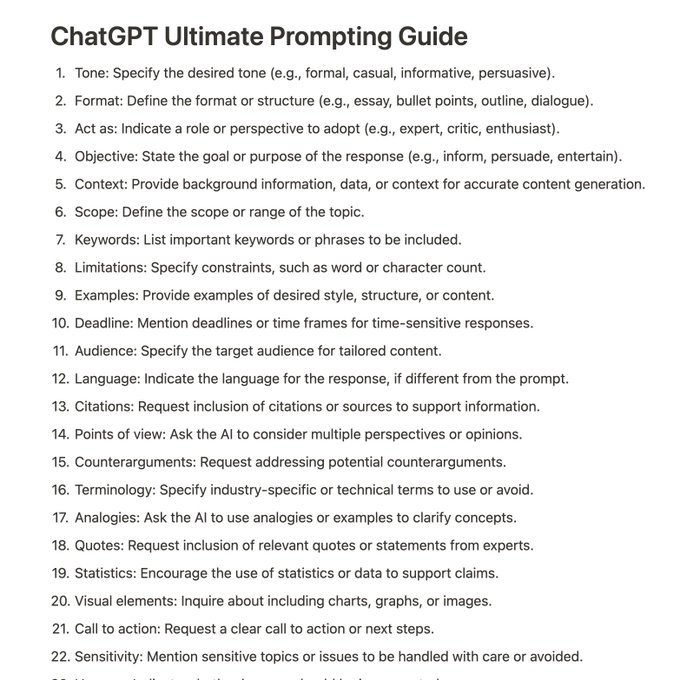
Mastering the Art of ChatGPT Prompts to Get Better Answers
The chart below demonstrates, for example, ChatGPT prompts to Get Better Answers and how artificial intelligence is driving the changes that happen in communication and interaction on the internet as we know it today. ChatGPT is one of the state-of-the-art conversational models from OpenAI as part of the GPT (Generative Pre-trained Transformer) family. Even though it has very powerful capabilities when used to output responses, they are highly dependent on how well its prompts are constructed. The purpose of this post is to show you how to write great ChatGPT Prompts that will help you achieve the best output from ChatGPT.
Key Takeaways
- To tailor prompts to ChatGPT, you need to understand what your audience is looking for.
- Prompts that are clear, contextual, and empathetic will enable AI interactions to feel more human.
- Different types of prompts, whether questions or open-ended ones, can diversify and improve the versatility of conversations with ChatGPT.
- A continual approach — tweaking and retweaking future prompts based on past interactions and feedback to achieve the most optimal results.
Introduction
ChatGPT has revolutionized the way we approach AI interactions, making it possible to generate human-like text with ease. However, the key to unlocking its full potential lies in the art of crafting well-constructed prompts. In this guide, we’ll explore the nuances of writing prompts that yield better answers from ChatGPT, ensuring more meaningful and engaging interactions.

Understanding Your Audience
Before you begin crafting prompts, it’s essential to understand your audience. Whether you’re creating content for AI enthusiasts or everyday users, knowing their needs and preferences will help you tailor your prompts more effectively.
Recognize Audience Needs
The first step is to identify what your audience is looking for. Are they seeking detailed explanations, quick tips, or creative suggestions? Understanding this will allow you to frame your prompts to meet those specific needs.
Tailor Your Approach
Different audiences require different approaches. For instance, AI enthusiasts might appreciate technical jargon and in-depth analysis, while casual users might prefer simple and direct language. Tailor your prompts accordingly to cater to these varied preferences.
Clarity and Context
Clear and context-specific prompts are crucial for eliciting accurate and relevant responses from ChatGPT. Ambiguous or vague prompts can lead to confusing or irrelevant answers, diminishing the effectiveness of your interaction.
Be Specific
When crafting prompts, specificity is key. Instead of asking, “Tell me about AI,” try asking, “Can you explain the key differences between supervised and unsupervised learning in AI?” This provides clear direction and context, leading to more precise answers.
Provide Background Information
Including relevant background information in your prompts helps ChatGPT understand the context better, resulting in more coherent responses. For example, if you’re discussing a historical event, mention the period and key figures involved.
Empathy in Prompts
Incorporating empathy into your prompts can significantly enhance the quality of responses. Empathetic prompts encourage ChatGPT to generate more human-like and engaging answers, making the interaction feel more personal.
Humanize Your Language
Use natural language and conversational tones in your prompts. This not only makes the interaction more relatable but also helps ChatGPT produce responses that feel authentic and engaging.
Consider Emotional Impact
Think about the emotional impact of your prompts. Crafting prompts that acknowledge the reader’s feelings or concerns can lead to more thoughtful and compassionate responses.
Diversity in Prompt Styles
Experimenting with different prompt styles can enhance the versatility and effectiveness of your interactions with ChatGPT. From questions to open-ended prompts, each style has its unique benefits.
Questions
Questions are a straightforward way to engage ChatGPT. They provide clear direction and can be tailored to elicit specific types of information.
Instructions
Instruction-based prompts guide ChatGPT in performing specific tasks or following certain guidelines. This style is particularly useful for generating structured responses or step-by-step guides.
Open-Ended Prompts
Open-ended prompts encourage creativity and exploration. They allow ChatGPT to generate more detailed and nuanced answers, making the interaction richer and more informative.
Analyzing Past Interactions
Learning from previous interactions is essential for continuously improving your prompts. By analyzing feedback and past responses, you can refine your approach and achieve better results.
Gather Feedback
Collect feedback on the quality of ChatGPT’s responses. This can be done through surveys, user reviews, or direct interactions. Use this feedback to identify areas for improvement.
Refine Your Prompts
Based on the feedback, tweak and refine your prompts. Experiment with different phrasings and structures to see what works best. Continuous iteration is key to mastering prompt crafting.
Best Practices and Examples
To help you get started, here are some best practices for writing effective prompts, along with examples:
Be Clear and Concise
- Generic Prompt: “Tell me about AI.”
- Improved Prompt: “Explain the differences between AI and machine learning, and give examples of each.”
Use Natural Language
- Generic Prompt: “Describe the uses of AI.”
- Improved Prompt: “How is AI being used in healthcare, and what are its benefits?”
Provide Context
- Generic Prompt: “Discuss climate change.”
- Improved Prompt: “How has climate change impacted global weather patterns over the last decade?”
Many people complain about ChatGPT's results.
— Paul Couvert (@itsPaulAi) September 4, 2023
But you have to write the right prompt to get a good answer.
I show you the perfect ChatGPT Prompt formula in just a few steps ↓
1. Task
Begin with an action verb, specifying the desired output.
E.g.: Generate a table with… pic.twitter.com/Vc9MRf2PBm
Motivational Quotes on Communication Skills
Incorporating quotes into your prompt crafting practice can provide both inspiration and guidance. Here are a few quotes that highlight the essence of effective communication:
- “The art of communication is the language of leadership.” – James Humes.
- “Words are, of course, the most powerful drug used by mankind.” – Rudyard Kipling.
Reflecting on these quotes can inspire more thoughtful prompt creation, emphasizing clarity, empathy, and impact in every interaction you design with ChatGPT.
FAQ
Here are some FAQs about ChatGPT prompts and interactions with AI to help you further with creating your prompts.
A high-quality ChatGPT prompt is highly specific and contextual, which is informative enough for the AI to return a response and direct it to the type of reader you want.
Craft well-structured prompts put context, and add empathy to improve the quality of responses. Analyzing feedback regularly helps to enhance the level of this call to action.
Yes, you can use ChatGPT to create original creative writing! With innovative, whimsical prompts, you can create story sparks and character dialogue snippets.
Stay Updated with AI Developments and Enhance Your Prompt Crafting Skills
Consider exploring these recommended resources:
- OpenAI Blog: Delve into the latest updates on AI technology advancements and insightful articles.
- AI Alignment Forum: An extensive platform discussing theories and practices in AI safety and alignment.
- Towards Data Science on Medium: A popular blog covering a wide range of AI topics, including practical tutorials and research updates.
These resources offer valuable insights and are excellent starting points for anyone looking to deepen their understanding of AI trends and developments.
For further exploration of effective prompt crafting, check out Mastering ChatGPT Prompts for AI Enthusiasts. This resource provides additional insights and examples to help you refine your skills.

(IMG Source: Reddit)Conclusion
Crafting effective prompts is an art that can significantly enhance your interactions with ChatGPT. By understanding your audience, providing clear and context-specific prompts, incorporating empathy, and continuously refining your approach, you can unlock the full potential of AI interactions. Apply the knowledge gained from this guide, and watch your ChatGPT conversations become more engaging and meaningful.
Happy prompting!









2 Responses